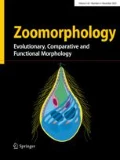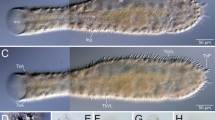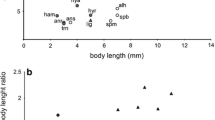Summary
Woodlice are unique among the arthropods in moulting in two halves. The intramoult is 1.8 days inOniscus asellus and results from the two halves being out of synchrony throughout the cycle. In the integument, the initiation of a new moult cycle is heralded by epidermal cell vacuolation; a little later, the subepidermal tissue proliferates and, for a brief time, macrophages appear. The cuticle layers are produced in order, starting with epicuticular structures such as tricorns and plaques, followed by the biphasic epicuticle, the lamellate pre-ecdysial cuticle and, after ecdysis, the lamellate postecdysial cuticle. Epicuticle is formed in a continuous sheet along the distal epidermal membrane and postecdysial cuticle from fibres formed within the cell body — both features not reported for other arthropods. Immediately prior to ecdysis the epicuticle and pre-ecdysial cuticle are highly corrugated and the epidermis very constricted as the width of the ecdysing gap is increased by the new cuticle components withdrawing slightly beneath the old cuticle. At this time the space between the two cuticles appears devoid of the fluid that once occupied it, although the ecdysial membrane is still apparent. After ecdysis the appearance of the epicuticle changes due to chemical events which make it relatively impermeable. The pre-ecdysial cuticle also changes in appearance at this time due to the physical stress of expansion. Large cuticle precursor vesicles, similar to those of other Crustacea, are particularly associated with postecdysial cuticle production. In addition there are numerous small vesicles associated with pre-ecdysial cuticle formation. The epidermal vacuoles disappear as postecdysial cuticle is produced so that, when it is complete, the epidermis is again a narrow cell layer. Apolysis occurs straight after this and shortly afterwards the cycle recommences.
Unlike other arthropods woodlice do not expand to break free of the old cuticle instead they walk free of either half and then expand. Experimental evidence is given which suggests that woodlice do not take in water to achieve this expansion but rather, they appear to employ internal hydrostatic pressure.
Using published data from woodlice endocrinological studies and the present work a possible method of hormonal control of the biphasic moult is suggested.
Similar content being viewed by others
References
Baumberger JP, Olmsted JMD (1928) Changes in the osmotic pressure and water content of crabs during the molt cycle. Physiol Zool 1:531–549
Birstein YaA (1964) Freshwater isopods (Asellota). In: Pavlouskii EN, Shtakel'berg AA (eds) Fauna of U.S.S.R., Crustacea Vol III, No 5. Zoological Institute of the Academy of Sciences of the U.S.S.R. New Series No 47. Jerusalem: Israel Program for Scientific Translations
Carlisle DB (1956) Studies on the endocrinology of isopod crustaceans. Moulting inLigia oceanica (L.). J Mar Biol Ass UK 35:515–520
Edney EB (1968) Transition from water to land in isopod crustaceans. Am Zool 8:309–326
George RY (1972) Biphasic moulting in isopod Crustacea and the finding of an unusual mode of moulting in the Antarctic genusGlyptonotus. J Nat Hist 6:651–656
George RW, Sheard K (1954) Ecdysis in the isopodPorcellio scaber (Latreille). Aust J Zool 2:75–85
Gorvett H (1956) Tegumental glands and terrestrial life in woodlice. Proc Zool Soc London 126:291–314
Green JP, Neff MR (1972) A survey of the fine structure of the integument of the fiddler crab. Tissue and Cell 4:137–171
Gubb D (1975) A direct visualisation of helicoidal architecture inCarcinus maenas andHalocynthia papillosa by means of scanning electron microscopy. Tissue and Cell 7:19–32
Halcrow K (1976) The fine structure of the carapace integument ofDaphnia magna Strauss (Crustacea Branchiopoda). Cell Tissue Res 169:267–276
Hartenstain R (1968) Nitrogen metabolism in the terrestrial isopodOniscus asellus. Am Zool 8:507–519
Heeley W (1941) Observations on the life-histories of some terrestrial isopods. Proc Zool Soc London ser B 3:79–149
Holdich DM, Mayes KR (1975) A fine-structural re-examination of the so-called ‘midgut'ld of the isopodPorcellio. Crustaceana 29:186–192
Jenkin PM, Hinton HE (1966) Apolysis in arthropod moulting cycles. Nature London 211:871
Kawaguti S, Ikemoto N (1962) Electron microscopy of the integument structure and its calcification process during moulting in a crayfish. Biol J Okayama University 8:43–58
Krishnakumaran A, Schneiderman HA (1969) Induction of molting in Crustacea by an insect molting hormone. Gen Comp Endocr 12:515–518
Laverack MS (1976) External proprioceptors. In: Mill PJ (ed.) Structure and function of proprioceptors in the Invertebrates. Chapman Hall, London p 686
Locke M (1976) The role of plasma membrane plaques and golgi complex vesicles in cuticle deposition during the moult/intermoult cycle. In: Hepburn HR (ed.) Insect integument. Elsevier Sci Pub Co, Oxford p 577
Maissiat J, Graf F (1973) Action de l'ecdysterone sur l'apolsis et l'ecdysis de divers Crustacés Isopodes. J Insect Physiol 19:1265–1276
Martin G, Mocquard J-P, Besse G (1979) Controle neurohumoral de la mue chez les femelles de l'oniscoidePorcellio dilatatus Brandt. Bull Soc Sci Nat Tunisie 14:47–58
Mayes KR, Holdich DM (1975) Water exchange between woodlice and moist environments, with particular reference toOniscus asellus. Comp Biochem Physiol 51 A:295–300
Mead F (1976) La place de l'accouplement dans le cycle de reproduction des isopodes terrestres (Oniscoidea). Crustaceana 31:27–41
Messner B (1965) Ein morphologisch-histologischer Beitrag zur Häutung vonPorcellio scaber Latr. undOniscus asellus L. (Isopoda Terrestria). Crustaceana 9:285–310
Neville AC (1975) Biology of Arthropod cuticle. Springer, Berlin-Heidelberg-New York p 448
Passano LM (1960) Molting and its control. In: Waterman TH (ed.). The Physiology of Crustacea Vol. I Academic Press, New York-London p 670
Price JB (1978) Studies on the blood and cuticle of woodlice. Ph. D. Thesis. University of Nottingham
Price JB, Holdich DM (1980a) The formation of the epicuticle and associated structures inOniscus asellus (Crustacea. Isopoda). Zoomorphologie 94:321–332
Price JB, Holdich DM (1980b) Changes in osmotic pressure and sodium concentration of the haemolymph of woodlice with progressive desiccation. Comp Biochem Physiol 66A:297–305
Sutton SL (1972) The study of woodlice. Ginn and Co. Ltd., London pp 144
Szyfter Z (1966) The correlation of moulting and changes occurring in the hepatopancreas ofPorcellio scaber Latr. (Crustacea, Isopoda). Bull Soc Amis Sci Lett Poznan D 7:95–114
Taylor RL, Richards AG (1965) Integumentary changes during moulting of arthropods with special reference to the subcuticle and ecdysial membrane. J Morphol 116:1–22
Yamaoka LH, Scheer BT (1970) Chemistry of growth and development in crustaceans. In: Florkin M, Scheer BT (eds.) Chemical Zoology Vol. V, Arthropoda A. Academic Press, New York-London p 460
Author information
Authors and Affiliations
Rights and permissions
About this article
Cite this article
Price, J.B., Holdich, D.M. An ultrastructural study of the integument during the moult cycle of the woodlouse,Oniscus asellus (Crustacea, Isopoda). Zoomorphologie 95, 250–263 (1980). https://doi.org/10.1007/BF00998125
Received:
Issue Date:
DOI: https://doi.org/10.1007/BF00998125




